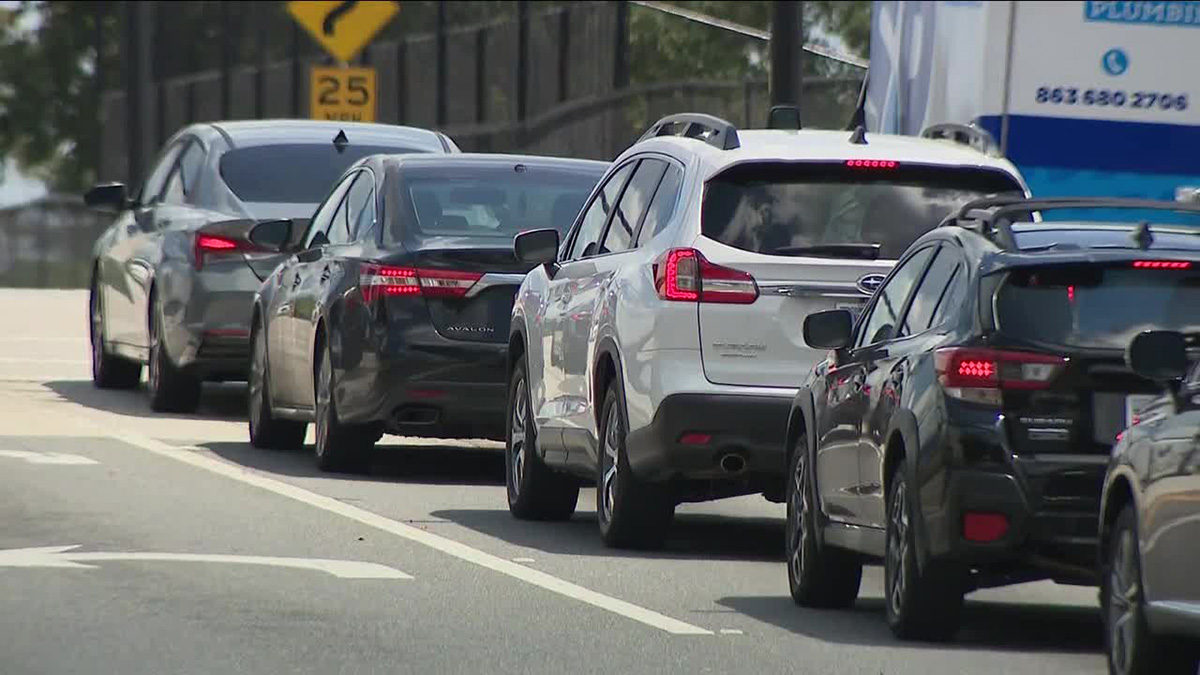

Finance
Why Is Florida Auto Insurance So Expensive?
Published: November 5, 2023
Find out why auto insurance rates in Florida are so high and how it impacts your finances. Discover strategies to save money on your Florida auto insurance.
(Many of the links in this article redirect to a specific reviewed product. Your purchase of these products through affiliate links helps to generate commission for LiveWell, at no extra cost. Learn more)
Table of Contents
Introduction
When it comes to auto insurance rates, Florida seems to be in a league of its own. Many residents are left wondering why their premiums are consistently higher compared to other states. The truth is, there are several factors that contribute to the high cost of auto insurance in the Sunshine State. Understanding these factors can help drivers navigate the complexities of acquiring and maintaining the necessary coverage.
While each individual’s insurance rate is determined by various factors, such as their driving history, age, and type of vehicle, there are overarching elements that affect the overall insurance landscape in Florida. In this article, we will explore several reasons why auto insurance in Florida is so expensive, shedding light on the unique challenges faced by drivers in the state.
From high accident rates to extreme weather conditions and costly litigation processes, the combination of factors in Florida makes it a hotbed for expensive auto insurance premiums. Let’s delve deeper into each factor to understand how it contributes to the high cost of insuring vehicles in the state.
High Accident Rates
One of the primary reasons why auto insurance in Florida is so expensive is the high rate of accidents. Florida consistently ranks among the states with the highest number of car accidents per year. The busy roadways and congested cities, such as Miami and Orlando, contribute to the increased risk of accidents.
Furthermore, factors like distracted driving, speeding, and reckless behavior on the roads all contribute to the high accident rates. Florida’s diverse population and tourists from around the world also add to the mix, as unfamiliarity with local driving norms can lead to more accidents.
The frequency of accidents means insurance companies have to pay out more claims, resulting in higher premiums for all drivers. Additionally, Florida follows a “no-fault” insurance system, which means that each driver’s insurance company is responsible for paying their damages, regardless of who is at fault. This further increases the cost of insurance in Florida.
To mitigate the financial impact of accidents, it is essential for Florida drivers to maintain proper insurance coverage. By driving safely and following traffic laws, motorists can reduce their risk of being involved in an accident and potentially lower their insurance premiums.
No-Fault Insurance Laws
Florida operates under a “no-fault” insurance system, which means that regardless of who is at fault in an accident, each driver’s insurance company is responsible for covering their own losses. This system is intended to expedite the claims process and ensure that accident victims receive prompt medical treatment and compensation.
While the no-fault system has its benefits, it also contributes to the high cost of auto insurance in Florida. Under this system, drivers are required to carry Personal Injury Protection (PIP) coverage, which provides medical expenses and lost wages regardless of fault. Florida law mandates a minimum PIP coverage of $10,000.
The PIP requirement adds an extra layer of mandatory coverage that drivers must carry, increasing their overall insurance premiums. Additionally, fraudulent claims and overutilization of medical services have plagued the PIP system in Florida, leading to higher costs for insurance companies and ultimately higher premiums for drivers.
Furthermore, the no-fault system can make it challenging for accident victims to recover compensation for certain damages. In cases of severe injuries or significant property damage, individuals may need to pursue legal action against the at-fault party to seek additional compensation. This can lead to a lengthy and costly litigation process.
Overall, the no-fault insurance laws in Florida contribute to the high cost of auto insurance, both due to the mandatory PIP coverage and the complexities involved in seeking full compensation for damages beyond what PIP covers.
PIP (Personal Injury Protection) Coverage Requirement
In Florida, one of the main contributors to the high cost of auto insurance is the requirement for drivers to carry Personal Injury Protection (PIP) coverage. PIP coverage is a form of no-fault insurance that ensures medical expenses and lost wages are covered for the policyholder, regardless of who is at fault in an accident.
The state of Florida mandates that all drivers carry a minimum of $10,000 in PIP coverage. While PIP coverage is designed to provide quick access to medical treatment and compensation, it also adds to the overall cost of auto insurance in the state.
The requirement to carry PIP coverage means that every driver must allocate a portion of their insurance premium to cover these costs. This mandatory coverage increases the base cost of insurance for all drivers, even if they have an exemplary driving record.
Another factor contributing to the high cost of PIP coverage in Florida is the prevalence of fraudulent claims. Unfortunately, the state has experienced a significant number of fraudulent activities related to PIP coverage, leading to increased costs for insurance companies. These fraudulent activities include staged accidents, unnecessary medical treatments, and exaggerated claims.
To combat these fraudulent claims, insurance companies often have to increase premiums for all policyholders. This means that even law-abiding drivers who have never been involved in an accident end up paying higher premiums due to the actions of a few individuals.
However, it’s worth noting that the state of Florida has taken measures to address the issue of fraudulent PIP claims. Reforms have been implemented to reduce fraudulent activities and control costs, but the impact on premiums may take time to be fully realized.
Overall, the requirement to carry PIP coverage in Florida is a significant contributing factor to the high cost of auto insurance. The mandatory coverage, coupled with the prevalence of fraudulent claims, can lead to increased premiums for all drivers in the state.
Uninsured/Underinsured Drivers
Another factor that contributes to the high cost of auto insurance in Florida is the significant number of uninsured or underinsured drivers on the road. Despite the state’s requirement for drivers to carry auto insurance, there are still many individuals who disregard this legal obligation.
In fact, according to recent estimates, it is believed that around 20% of Florida drivers are uninsured. This means that if an uninsured driver causes an accident, the other party may face difficulties in recovering their damages and medical expenses.
When uninsured or underinsured drivers are involved in accidents, it often falls on the insurance of the other party to cover the costs. This can lead to an increase in premiums for insured drivers, as the insurance companies have to bear the financial burden of uninsured motorists.
In addition, those drivers who do carry insurance may opt for minimum coverage in order to save money on their premiums. Unfortunately, this can create a situation where the coverage is insufficient to fully compensate for the damages caused by an accident.
To protect themselves from the risks associated with uninsured or underinsured drivers, Florida drivers are encouraged to carry uninsured/underinsured motorist coverage (UM/UIM). This coverage can provide financial protection if they are involved in an accident with a driver who either does not have insurance or has inadequate coverage.
However, this additional coverage adds to the overall cost of auto insurance in Florida. Drivers who choose to carry UM/UIM coverage will see higher premiums compared to those who only carry the minimum required coverage.
In summary, the prevalence of uninsured or underinsured drivers in Florida contributes to the higher cost of auto insurance. The financial burden of accidents caused by uninsured motorists is passed on to insured drivers, resulting in increased premiums for everyone.
High Population and Tourism
Florida’s high population and booming tourism industry also play a significant role in driving up the cost of auto insurance in the state. As one of the most populous states in the country, with over 21 million residents, the sheer number of drivers on the road increases the likelihood of accidents and subsequently, insurance claims.
Furthermore, Florida attracts millions of tourists each year, drawn to its beautiful beaches, theme parks, and vibrant cities. The influx of tourists means that the roads become even more crowded, leading to increased congestion and a higher risk of accidents.
Insurance companies take into account the population density and the volume of tourists when determining insurance rates. The higher the population, the greater the likelihood of accidents, which leads to higher premiums for all Florida drivers.
In addition, tourists who visit Florida from other states or countries may not be familiar with local driving laws and road conditions. This lack of familiarity can contribute to an increased risk of accidents and can also complicate insurance claims if an out-of-state driver is involved in an accident.
With the large influx of tourists, insurance companies have to factor in the potential risks associated with this transient population. As a result, the costs of insuring vehicles in Florida are impacted, making auto insurance premiums more expensive for both residents and visitors alike.
Overall, the high population and thriving tourism industry in Florida contribute to the increased risk of accidents and higher insurance premiums. This underscores the importance of maintaining proper auto insurance coverage to protect against potential accidents and liabilities.
Extreme Weather Conditions
Florida is infamous for its extreme weather conditions, including hurricanes, tropical storms, and heavy rainfall. While these weather phenomena make the state an appealing destination for many, they also contribute to the high cost of auto insurance.
The risk of severe weather events brings with it an increased likelihood of damage to vehicles. Hail, strong winds, and flooding can cause significant damage to cars, leading to insurance claims and higher premiums.
In addition, hurricanes pose a substantial risk in Florida. The state is prone to hurricane activity, particularly during the Atlantic hurricane season, which runs from June to November. Hurricanes can cause widespread destruction, including damage to vehicles due to falling debris, flooding, and high winds.
Insurance companies factor in the risks associated with extreme weather events in Florida when determining auto insurance premiums. The higher the risk of weather-related damage, the more insurance companies have to pay out in claims, leading to increased costs for policyholders.
Furthermore, the aftermath of severe weather events often leads to a surge in demand for auto repairs and replacement parts. The increased demand, coupled with supply chain disruptions, can drive up the cost of repairs, and insurance companies may pass these costs onto policyholders in the form of higher premiums.
It is crucial for Florida drivers to assess their insurance coverage and ensure it adequately protects against weather-related risks. Comprehensive coverage, which includes protection against weather-related damage, can help mitigate the financial impact of severe weather events.
Overall, the extreme weather conditions in Florida, especially hurricanes and tropical storms, contribute to the higher cost of auto insurance. Insurance companies account for the increased risk of weather-related damage, which translates into higher premiums for drivers in the state.
Expensive Medical Costs
Another factor that contributes to the high cost of auto insurance in Florida is the soaring expense of medical care. In the event of an accident, the cost of medical treatment and rehabilitation can quickly escalate, and insurance companies must factor in these costs when determining premiums.
Medical costs, including hospitalizations, surgeries, and follow-up care, have been steadily rising across the nation, and Florida is no exception. The state has some of the highest medical costs in the country, which directly affects the cost of auto insurance.
Additionally, Florida’s mandatory Personal Injury Protection (PIP) coverage, as mentioned earlier, requires drivers to carry a minimum of $10,000 in medical coverage. This requirement further contributes to the overall cost of insurance in the state.
Insurance companies must anticipate the potential expenses associated with providing medical coverage to policyholders and adjust their premiums accordingly. The higher the medical costs, the more expensive the auto insurance premiums become.
Moreover, Florida’s large retiree population also drives up medical expenses. With a significant number of elderly residents, there is a higher likelihood of injuries resulting in more complex and costly medical treatments.
To help mitigate the impact of expensive medical costs, it is essential for Florida drivers to carefully review their insurance policies and consider obtaining additional coverage, such as higher PIP limits or medical payment coverage. This can provide extra protection in the event of a severe accident.
Overall, the steep and rising costs of medical care in Florida have a direct impact on auto insurance premiums. The need to anticipate and cover these expenses, coupled with the state’s mandatory PIP coverage, leads to higher overall insurance costs for drivers.
Fraudulent Car Insurance Claims
Fraudulent car insurance claims are a significant factor contributing to the high cost of auto insurance in Florida. The prevalence of fraudulent activities in the state has been a longstanding issue, resulting in increased expenses for insurance companies and subsequently, higher premiums for drivers.
There are various forms of fraudulent car insurance claims, including staged accidents, fake injuries, and inflated property damage claims. Unscrupulous individuals may collude with others to orchestrate accidents or intentionally cause damage to their vehicles to file fraudulent claims.
Florida has been notorious for its “PIP mills,” where individuals take advantage of the state’s mandatory Personal Injury Protection (PIP) coverage to submit fraudulent claims for unnecessary medical treatments. This abuse of the system drives up insurance costs for everyone.
Insurance companies are required to investigate claims to determine their legitimacy, which involves allocating resources, time, and money. This additional expenditure in detecting and combating fraudulent activities puts financial pressure on the insurance industry, ultimately leading to higher premiums for policyholders.
In response to the rampant fraudulent car insurance claims, the state of Florida has implemented legislation and reforms to curtail the problem. The aim is to prosecute individuals involved in fraudulent activities and implement stricter regulations to prevent further abuse of the system.
However, it is an ongoing battle, and insurance companies continue to factor in the risks associated with fraudulent claims when determining insurance premiums. Honest drivers end up bearing the burden through increased premium costs.
To protect themselves, Florida drivers are encouraged to be cautious and vigilant. It is important to report any suspicious activities or accidents that seem staged or involve potential fraud to the appropriate authorities or insurance companies. By doing so, drivers can help combat fraud and potentially minimize the impact on insurance premiums.
Overall, the prevalence of fraudulent car insurance claims in Florida significantly contributes to the high cost of auto insurance. The insurance industry must allocate resources to combat fraud, which ultimately affects the premiums paid by honest and law-abiding drivers in the state.
Costly Litigation Process
The lengthy and expensive litigation process in Florida adds to the high cost of auto insurance in the state. When an accident occurs and the parties involved cannot reach a settlement, the case may end up in court, leading to increased legal fees, court costs, and resulting insurance premiums.
Florida follows a “no-fault” insurance system, which means each driver’s insurance company is responsible for paying their own medical expenses and lost wages, regardless of fault. However, in certain cases, particularly those involving severe injuries or significant property damage, it may be necessary for the injured party to pursue legal action against the at-fault driver to seek additional compensation beyond what the insurance company provides.
The litigation process can be lengthy and costly, involving legal fees, court costs, expert witnesses, and other expenses. Insurance companies must anticipate these potential costs and build them into their pricing structure, leading to higher premiums for policyholders.
Moreover, Florida has seen a rise in the number of lawsuits filed against insurance companies, particularly related to personal injury protection (PIP) claims. These lawsuits, often driven by healthcare providers, aim to challenge insurance companies’ denial or reduction of medical expenses. The costs associated with defending against these lawsuits and the potential for substantial payouts can significantly impact insurance premiums.
The higher costs associated with the litigation process inevitably impact insurance companies’ bottom line and are passed on to policyholders in the form of increased premiums.
Efforts have been made to address the issue of costly litigation in Florida. Legislative reforms have been implemented to tackle fraud and reduce frivolous lawsuits, aiming to streamline the claims process and lower insurance costs. However, the impact of these reforms takes time to fully materialize and may not have an immediate effect on premiums.
To manage costs associated with the litigation process, it is crucial for Florida drivers to maintain proper insurance coverage. Comprehensive coverage and higher liability limits can offer financial protection in the event of a lawsuit, minimizing out-of-pocket expenses and potential increases in insurance premiums.
In summary, the costly and protracted litigation process in Florida contributes to the high cost of auto insurance in the state. Insurance companies factor in potential legal fees and litigation costs when determining premiums, ultimately impacting policyholders’ insurance costs.
Conclusion
The high cost of auto insurance in Florida can be attributed to a combination of factors that create a unique insurance landscape in the state. From the high accident rates and the no-fault insurance laws to the prevalence of uninsured drivers and the expensive medical costs, Florida drivers face numerous challenges when it comes to obtaining affordable coverage.
The population density and thriving tourism industry contribute to congested roads and an increased risk of accidents. Additionally, extreme weather conditions, such as hurricanes, further compound the risks and costs associated with insuring vehicles in the state.
Moreover, the mandatory Personal Injury Protection (PIP) coverage requirement and the prevalence of fraudulent car insurance claims drive up insurance premiums for all drivers. The costly litigation process adds another layer of expense to the insurance landscape in Florida.
Despite these challenges, there are steps that Florida drivers can take to help mitigate the high cost of auto insurance. By driving safely and maintaining a clean driving record, individuals may be eligible for certain discounts and incentives from insurance companies. Additionally, reviewing and adjusting coverage limits, deductible amounts, and considering various coverage options can help strike a balance between adequate protection and affordability.
It is important for individuals to shop around and compare quotes from different insurance providers to find the best coverage at the most competitive rates. Insurance companies may have different criteria and algorithms for determining premiums, so it pays to do thorough research and consider multiple options.
While the cost of auto insurance in Florida may seem daunting, by understanding the contributing factors and exploring available options, drivers can find ways to manage their insurance costs effectively. By maintaining appropriate coverage, driving responsibly, and being proactive, Florida drivers can navigate the complexities of the insurance market and ensure they are adequately protected on the road.














